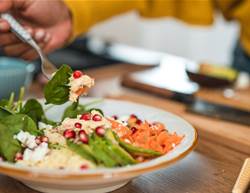Chances are you’ve seen reports highlighting the many benefits of the Mediterranean diet at least a few times over the years. An ever-growing body of evidence shows that this traditional style of eating is one of the most effective ways to reach a healthy weight, feel great, and live a long and vigorous life. But in a world where confusion over healthy eating and the best diets reign supreme, what exactly does it mean to eat Mediterranean, and what can this ancient diet do for you and your family?
What is the Mediterranean diet?
In the late 1950s American physiologist and dietary researcher Ancel Keys was conducting research in southern Italy and Greece when he made a surprising discovery: the people who lived in countries that bordered the Mediterranean Sea seemed healthier than any of the other populations he’d studied around the globe. In fact, they enjoyed some of the longest lives and lowest heart disease rates in the world.
Keys could have attributed the benefits to the abundant sunshine or invigorating salt water. But what if, he wondered, they resulted from the food? The people in this region had diets focused on fresh fruits and vegetables, whole grains and beans. They used olive oil (and plenty of it) as their primary fat. They flavoured their food with herbs and spices instead of salt. And they ate very little meat and few refined carbohydrates or processed foods.
Since then, Keys’s theory has been proved. An ever-growing body of evidence showsthat the Mediterranean style of eating is one of the most effective ways to maintain a healthy weight, feel great, and live a long, vigorous life. In fact, a five-year study of nearly 8,000 adults concluded that following a Mediterranean diet could reduce the risk of heart disease by up to 30 per cent.
Adopting this approach to eating is a matter of shifting into the centre of your plate many of the foods you already enjoy – fruits, vegetables, whole grains, legumes, healthy fats and seafood. As you eat more of these foods, you’ll naturally have less room for unhealthy ones.
Here are 11 simple steps you can take to give your diet a Mediterranean makeover.
Go with the seasonal flow
Instead of trying to create a meal plan out of thin air, let the seasons be your guide. If the market is overflowing with fresh carrots or green beans, for instance, there’s a good bet that they’re at their peak of deliciousness (and at their cheapest, too!), so build your meals around these fresh ingredients.
Check your condiments
The old Aussie stand-by of tomato or barbecue sauce is laden with sugar. Give your food flavour instead with a smear of mustard. And give sandwiches a creamy flavour
kick with avocado, hummus or tapenade.
Find new uses for bread
When you eat Mediterranean, bread isn’t just for sandwiches. Toss crunchy toasted wholegrain bread into a salad as a nutritious alternative to white croutons. If you have leftover wholegrain bread that’s just starting to go stale, use it for thickening soups or stews.
Think simple for snacks
This means sticking with foods in their most natural, whole form – like fresh fruits and vegetables or nuts and seeds – rather than highly processed foods. Make a batch of crunchy carrot and celery crudités, hummus, olives and roast pepper dip that you can reach for throughout the week.
Start with a pile of greens
In many parts of the Mediterranean region, a meal is not complete without a heaping mound of lettuce, spinach, kale, silverbeet or dandelion. Rethink your usual mealtime ratios by having a large green salad and keep servings of meat, poultry, fish or vegetarian protein to about the size of your palm, rather than the reverse.
Make a meal out of your sides
Take a cue from Spanish-style tapas or Middle Eastern meze platters and create a meal from several vegie-centric, entree-style dishes (like lentil and fetta stuffed zucchini and red capsicum). You’ll be surprised by how satisfying a selection of small plates can be.
Treat meat as a flavour enhancer
Use smaller portions of protein in vegetable-based dishes. Try tossing a little shredded chicken or beef into a grain-and-vegetable pilaf, or tuck some into stuffed peppers or mushrooms along with whole grains, nuts and herbs.
Bake with whole grain flours
Wholemeal flour is a great option, as are cornflour, rye flour and buckwheat. Try substituting half of the white flour for wholegrain flour in your favourite baked treats or savoury muffins.
Make your dairy savoury rather than sweet
Yoghurt is always tasty with fruit, but it’s wonderful in savoury dishes, too. A dollop of cool, tangy yoghurt is an ideal contrast for vegetables like warm, earthy beetroot. Meanwhile, protein-rich fetta paired with tomato, cucumber, fresh herbs and olives makes a satiating meal, especially when accompanied by wholegrain bread. In general, when choosing cheeses, ricotta, fetta, cottage cheese and parmesan are lighter choices.
Go with the grain
Make whole grains and legumes your meal base, including beans, chickpeas and lentils. If you’re cooking dry beans from scratch, cook up a single batch on Sundays to add to your recipes all week long. Tinned varieties can be handy if you check for the amount of added salt.
Give your food a flavourful finish
Mediterranean eaters drizzle olive oil on their food all the time. Oil is high in kilojoules, though, so adding more might not make sense if you’re trying to lose weight. Still, as a rule of thumb, it’s fine to drizzle a teaspoon (about 200 kJ or 50 cal) of extra virgin olive oil on your meal before serving. You can also top dishes with fresh lemon juice, chopped basil, parsley or coriander, or a sprinkling of chillies for a pop of flavour.










